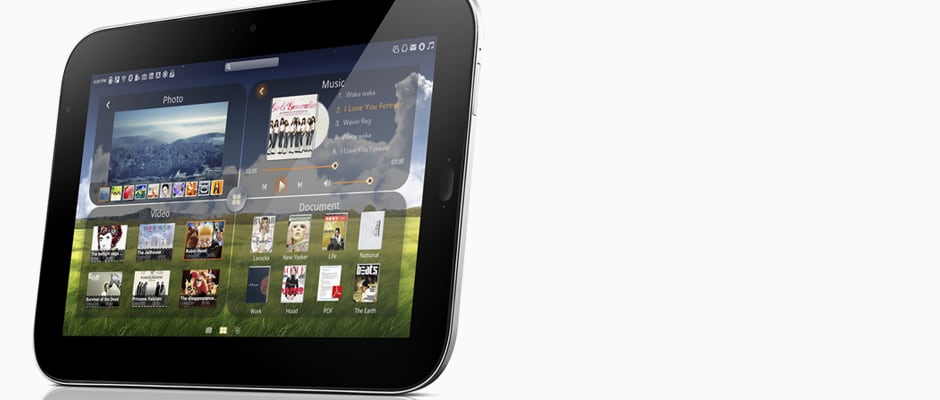Pros
Cons
Introduction
Design & Usability
{{section_header}}{{section.name}}{{/section_header}}
At 1.65 lbs, the {{product.name}} is a bit unwieldy.
Despite its odd shape, the {{product.name}} handles fairly well, but there are some weight issues that will make consumers strongly consider using both hands. Without a lap for it to rest on, users may run into fatigue issues—that's normal for tablets this size. The honeycomb pattern on the back allows for easier grip, but can only do so much.
Because there are only very limited physical controls (power/sleep/wake, volume, hold), the vast majority of your interactions with the device are going to be through the capacitive touch screen of the IdeaPad. It shares the same basic controls as every other Android 3 device, with swipes to change pages or screen, pinching to zoom, and taps to select or open files and links.
The {{product.name}} has a small number of physical ports on the outside of the unit, limited to a proprietary USB input, headset in, and a micro-HDMI out. As far as wireless connections go, the IdeaPad has a standard 802.11n wireless card, as well as Bluetooth 2.1 to tether peripherals to the device wirelessly. Not bad for the price.
{{photo_gallery "Front Image", "Back Image", "Side Image", "Front Size Comparison", "Packaging Contents Image", "Handling Front Image", "Handling Side Image"}}
Performance
You'll get your money's worth with the Lenovo IdeaPad K1.
Much like other 10.1-inch tablets, the {{ products(50fa2e0496ab5860160c6f06).name }} has a resolution of 1280 x 800, displayed on a screen that's 5.325 x 8.625 inches, giving it a DPI of 150. The IdeaPad uses an LCD screen backlit by an LED array, with a dubiously effective anti-glare coating. You'll notice at first that the screen size is rather large, like many of the other high-profile tablets to hit the market. While your eyesight may dictate how you feel about the tablet itself, the size may work to its detriment for younger users not accustomed to holding a heavier device like this for extended periods of time.
Tablets are generally not great to bring outside due to the way LCD screens work. In order to produce a picture, they rely on a backlight to be seen through the LCD matrix. If there is too much direct sunlight or an overall bright environment, this backlight is often drowned out, resulting in a picture that looks like it emits no light at all in comparison, causing consternation at the beach and other bright environments.
Because the IdeaPad is loaded with Google's Android 3.2, users are granted access to the wonderful world of the Android Market. While by the numbers it doesn't have as many apps as Apple's App Store (yet), the apps found in the Android market are typically much more friendly to developers and users who want to really unlock the capabilities of their beefed-up hardware (for example, cracking Bluetooth capabilities).
Conclusion
{{section_header}}{{section.name}}{{/section_header}}
Overall, not a bad tablet if your needs are basic.
The {{product.name}} is not a bad option if your needs are limited or if you want an entry-level tablet. It really doesn't set itself apart from other Android 3.2 tablets, although the button on the front of the device itself will help iPad users make the transition to Android if they end up choosing this product.
There are a few drawbacks to the IdeaPad, namely the fact that the battery is somewhat poor, although we've seen much worse. To be frank, the real concern is the dim screen, as that means it will be very hard to squeeze more battery life out of the tablet; what we reported is very close to the performance ceiling for the tablet without making some very dissatisfying tradeoffs.
All that being said, the {{product.name}} is a fairly solid and durable tablet with the beautiful and functional Android 3.2 operating system. You should have no issues or complaints about the basic functionality of the tablet, as the software support is great, and the interface is very easy to get used to.
If you can find this tablet on sale, and your needs for a tablet are not specialized or so advanced that you need to be the king of your living room, this isn't a bad pickup. Keep in mind the performance shortcomings, and if you're still okay with that, you'll be happy with your purchase.
Science Introduction
{{section_header}}{{section.name}}{{/section_header}}
The {{product.name}} is a choice tablet for those who aren't technophiles. Weighing in at over one-and-a-half pounds, this Lenovo isn't very mobile, but it serves its purpose.
Screen Performance
{{section_header}}{{section.name}}{{/section_header}}
Nothing really sets the IdeaPad's screen apart from those of its competitors
As previously mentioned, the {{product.name}} has a resolution of 1280 x 800, displayed on a screen that's 5.325 x 8.625 inches, giving it a DPI (dots per inch) of 150. This is about par for the course for tablets of this size, and really, there isn't a huge variance among the bigger contenders.
Like most tablets, the {{product.name}} doesn't fare so well when compared to the rec. 709 standard. By looking at the chart, you'll notice that it undersaturates and shifts reds and greens a bit, severely shifts the blues closer to a cyan color, as well as the white point being a little messed up. Comparatively speaking, the color isn't horrible, but it's not that great, either.
While we're used to LCD-screened tablets reflecting a ton of light, not many are as bad as the IdeaPad. Reflecting 26% of all light shone on the screen, the IdeaPad's reflection pattern is bold and annoying. We'd advise against taking this outside.
{{photo_gallery "Science Section 1 Images"}}
Battery Life
{{section_header}}{{section.name}}{{/section_header}}
Acceptable, but not extraordinary
The eReader battery life of the {{product.model}} is a little less than inspiring, clocking in at 6 hours and 45 minutes. The IdeaPad has an average battery life in this regard, but not enough to compete with the heavyweight tablets of the prior generation.
{{photo_gallery "Science Section 2 Images"}}
Other Tests
{{section_header}}{{section.name}}{{/section_header}}
{{photo_gallery "Other Tests Images"}}
Meet the tester
Jonathan Chan currently serves as the Lab Manager at Reviewed. If you clean with it, it's likely that Jon oversees its testing. Since joining the Reviewed in 2012, Jon has helped launch the company's efforts in reviewing laptops, vacuums, and outdoor gear. He thinks he's a pretty big deal. In the pursuit of data, he's plunged his hands into freezing cold water, consented to be literally dragged through the mud, and watched paint dry. Jon demands you have a nice day.
Checking our work.
Our team is here to help you buy the best stuff and love what you own. Our writers, editors, and experts obsess over the products we cover to make sure you're confident and satisfied. Have a different opinion about something we recommend? Email us and we'll compare notes.
Shoot us an email

